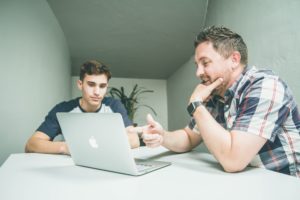
Photo by NeONBRAND on Unsplash
The premise behind individualized/personalized learning has been a driving force in my teaching for many years. I am a small rural school’s computer science teacher, and that leaves everything related to a computer under my purview. My class ranges from programming to computer design and from digital music to movie creation, all at the same time, in the same room. Therefore, stand and deliver is not an option and I am required to look at the best way to engage all. Though my classes and learning is going well, I know I can enhance my teaching practice. I am constantly reflecting upon this process to make sure all student’s needs are being met. This refinement is based on the ideas that each student has a say in their learning. This collaborative, yet personalized process, is a messy minefield that I question daily. I look at the students and can’t help but think the non-defined conclusion of personalized learning is antithetical to the way I was taught.
I am anchoring myself, every time I reflect, on the notion that what the students are learning is based on their goals and interests. To be honest, when I first tried this method, I had to fight my predetermined idea of what education was, based on my experience. If all students in my class of 30 are doing something different, is there any proof that the daily output is meeting this mythical standard I had in my mind; a standard that was cultivated when I was in school and was achieved by handing in a completed worksheet, or finishing the assigned questions? The more I research and the more I look at student engagement and finished product; I realize that none of these learning evidence pieces would exist if they were doing only what I prescribed. The question is, why is it so hard for me to practice what I truly believe will work for all, over what I know works for only some? Is my need for control worth more than their learning and expression?
Dumont, Istance, and Benavides (2010) discussed a socio-constructivist curricular paradigm looking at the role of personalized learning as integral to create adaptive minds that are flexible and creative. That is to say, the situation drives the answer, not the other way around. These authors state, “In order to support the progressive acquisition of adaptive expertise… [t]he teacher should leave open opportunities for ‘expressive outcomes’ – unanticipated results from the learning that takes place” (Dumont et.al, 2010, p. 4). The idea of pre-determined, form-fitting education as lacking real-world validity is echoed by other scholars.
Paul France (2020) was not shy at discussing the failings of standardized, impersonal curriculum. France states, “it’s clear that one-size-fits-all curriculum isn’t quite making the cut. As a result, the standardization movement has been met with a new movement: one that values differentiation, individualization, and personalization” (2020, p. 8). The premise of prescription over exploration creates a funnel that only allows for a predetermined set of outcomes to come to pass. France (2020), like Dumont et al. (2010), points out that executive function and flexibility is core to the goals of the curriculum when he states,
To create classrooms and schools that are fair, impartial, and equitable, we must remember that students need much more than appropriate academic content to reach their full potential. They need explicit instruction in executive functioning skills; they need to cultivate self-awareness, agency, and autonomy; and above all else, students need access and inclusion. (France, 2020, p.18)
These tenets are core in our curriculum documents in BC. Examples of these curricular tenets are, “[p]ersonal design choices require self-exploration and refinement of skills”, and “[t]ake creative risks in generating ideas and add to others’ ideas in ways that enhance them” (“Media design 10 | Building student success,” n.d.). With the latitude we are afforded as educators, we should endeavour to educate the whole student.
In conclusion, the more I read on the topic, and the more I practice personalized learning, leads me to feel validated in the efficacy of the curricular idea, but also feeling challenged to make sure that all learners are being reached and able to express their learning. I know there are areas I can, and must, improve in terms of both learner conferencing and goal creation, to name a few. I am actively trying new techniques, and adapting them to my whole classroom situation and the learners individually. Furthermore, it is hard to break the lessons of our past. The way I learned was successful for me, therefore that is how a class should look in my eyes. However, acknowledging that the way I learned as a youth is not functional to all, thus creating an equity gap in my class, is the unintended result if I am not willing to adapt. I have been using the personalized/individual approach for years, and the few failures I have seen thus far are more on my lack of conviction in the process, leading to only limited implementation. Once there is a solid scaffold, I have found the less the reigns are controlling the learner, the possibilities for the creation of the executive functions, needed in all life settings, are realized.
References
Dumont, H., D. Istance and F. Benavides (eds.) (2010), The Nature of Learning: Using Research to Inspire Practice, Educational Research and Innovation, OECD Publishing, Paris, https://doi-org.ezproxy.library.uvic.ca/10.1787/9789264086487-en.
France, P. (2020). Reclaiming personalized learning Thousand Oaks, CA: Corwin doi: 10.4135/9781544360652
Media design 10 | Building student success. (n.d.). Retrieved from https://curriculum.gov.bc.ca/curriculum/adst/10/media-design


